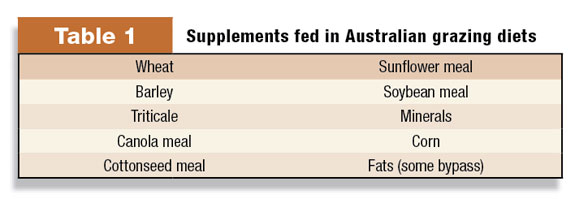Utilizing available resources efficiently has become a foundation for successful grazing operations. To effectively produce high-quality milk means more than providing pasture to the milking herd; it also means supplying a balanced ration alongside high-quality forages. Supplementing grazing cattle diets has the ability to achieve both of these goals.
An Australian perspective
Dairy producers in Australia, a country known for its grazing expertise, have relied on a lush and extensive pasture system to provide the nutrients their herds need to thrive. The pasture system has been embraced by Australian producers for multiple reasons, including:
- Available, high-quality forages. Pastures provide an energy dense and protein-dense source of nutrients and, when managed properly, can be a cost-effective approach to feeding cattle.
- Efficient forage utilization. With cows serving as the harvesters of nutrients, forages are more quickly and efficiently converted from grass into milk. It also removes the “middle-man” – the grower – from making hay from the grass, and storing it before it’s fed. Cows are responsible for gathering their own nutrients, rather than the producer delivering feed directly to the cow.
- Reduced cost of production. Many of the costs associated with freestall and tie stall management no longer apply to grazing operations. This can reduce input costs and lead to greater income over feed cost (IOFC) for the dairy.
While grazing offers multiple benefits to the dairy producer, forages don’t always provide the consistent, balanced diet needed for peak performance year-round. In parts of the United States, for example, high-quality forages will not be as available in January as they are in July. Reduced availability and wavering quality can lead to inconsistent production.
This inconsistency – and the drive to boost milk production – has led Australian graziers to investigate dietary supplements, says Dr. Ian Lean. A nutrition consultant and dairy professor based in Australia, Dr. Lean has been on the forefront of introducing supplements to grazing diets to meet nutritional needs and improve milk production.

In Australia, a wide variety of supplements are fed to meet nutritional requirements. These supplements offer a consistent, balanced diet for forage-based rations ( see Table 1 ).
The supplements are most often provided to the herd at milking, where the dairyman can monitor intake and behavior. Rations can be tweaked based on forage quality and nutrient availability.
The right balance of these supplements alongside high-quality pasture has helped progressive graziers reach production levels as high as 30,000 lbs per cow per year, says Dr. Lean. For U.S. producers considering grazing, Dr. Lean notes the opportunity and production potential are there when management and feeding are properly addressed.
Grazing challenges
While a multitude of benefits and opportunities exist within a pasture-based system, Dr. Lean points out three challenges graziers face:
- Managing supplements. Keeping the rumen stable and healthy while feeding two or three times per day can be difficult, says Dr. Lean. He shares that effective fiber is important to monitor while supplementing cows with nutrients forages may lack, including buffers when silages are fed, ionophores to maintain rumen integrity and protein when needed to meet nutritional requirements.
One specific nutritional challenge Dr. Lean has experienced is high levels of potassium in forages. While potassium is especially important in lactating diets, cows fed high levels of potassium prior to calving can experience more cases of metabolic disorders like milk fever.
One important consideration for grazing ration formulation has been dietary cation-anion difference (DCAD) balancing. Feeding a high-quality, palatable anion supplement in the prefresh ration has helped Dr. Lean address high potassium levels found in the forages and keep a low or negative DCAD value in close-up rations.
- Optimizing pasture. It’s more than just letting the cows out on pasture, explains Dr. Lean. Intensive management of pasture entails planting and fertilizing high-quality grasses for growth and efficient use.
Dr. Lean notes that efficient pasture utilization does not mean maximum utilization, but rather allowing cows to harvest the greatest quantity of high-quality grasses at the right time.
- Maximizing efficiency. Ensuring cows are converting feed into milk is an important concept for all dairies, but even more so for grazing operations.
Depending on pasture location, animals may have to travel too far from pasture to the milking barn, diminishing feed efficiency. Proper paddock and laneway setup can help alleviate these challenges.
Seek leaders for learning
For dairy producers considering implementing a grazing system, seeing successful grazing operations in action should be the first step, advises Dr. Lean. He recommends producers considering this system to visit those who are already doing it right.
Dr. Lean shares the analogy that a freestall barn built incorrectly will cause a lot of pain in the future; grazing systems are no different, making the setup at the start critical.
Dr. Lean also notes that producers will need to be patient with their cows. It takes time for the animals to learn how to graze properly, especially those coming from freestall and tie stall barns. But once cows adapt to the system, opportunities abound for the dairyman.
If you are considering grazing systems, many factors will determine the program’s effectiveness. Delivering a balanced, supplemented ration to complement the high-quality forages can lead to peak performance, optimized efficiency and maximized IOFC for your dairy. PD

-
Elliot Block
- Senior Manager of Technology
- Arm & Hammer Animal Nutrition
- Email Elliot Block






